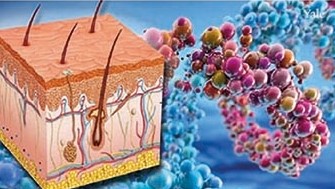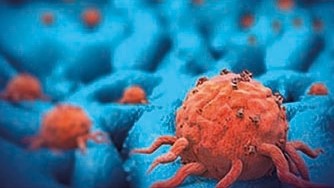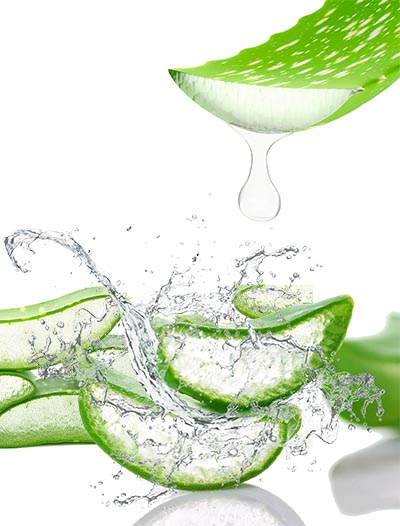Aloe in Nutrition and Health
Discover how Aloe Vera improves in a complete way your health products.
The plant Aloe Vera is used in Ayurvedic, Homoeopathic and Allopathic streams of medicine, and not only tribal com-munity but also most of the people for food and medicine. The plant leaves contain numerous vitamins, minerals, en-zymes, amino acids, natural sugars and other bioactive compounds with emollient, purgative, antimicrobial, anti-inflammatory, anti-oxidant, aphrodisiac, anti-helminthic, antifungal, antiseptic and cosmetic values for health care. Leaves in Aloe have three layers; the outer most layer consist of 600 Therapeutic and Medicinal Use of Aloe Vera: A Review 15 – 20 cells thick protective layer synthesizing carbohydrates and proteins. Aloe Vera gel has been reported to have a protective effect against damage to skin. Exact role is not known, but following the administration of aloe Vera gel, an antioxidant protein, metallothionein, is generated in the skin which scavenges hydroxyl radicals and prevents suppression of superoxide dismutase and glutathione peroxidase in the skin. It reduces the production and release of skin keratinocyte-derived immunosuppresive cytokines such as interlukin -10 and hence prevents UV-induced suppression of delayed type hypersensitivityctive components of aloe include anthraquinones, chromones, polysaccharides, and enzymes. The anthraquinones and chromones are responsible for the anti-cancer activity, antiinflammatory, and evacuating. The innermost layer of leaf gel contains water up to 99%, with glucomannans, amino acids, lipids, sterols and vitamins. It has numerous monosaccharide’s and polysaccharides; vitamins B1, B2, B6, and C; niacinamide and choline, several inorganic ingredients, enzymes (acid and alkaline phosphatase, amylase, lactate dehydrogenase, lipase) and organic compounds (aloin, barbaloin, and emodin). Therapeutically, it is used to prevent progressive dermal ischemia due to burns, frostbite, electrical injury and intra-arterial drug abuse. In vivo analysis of these injuries demonstrates that this gel acts as an inhibitor of thromboxane.

The Aloe Vera plays a chief role in stimulation of the complement linked to polysaccharides, hydration, insulation, and protection. Application of fresh gel to normal human cells in vitro promoted cell growth and attachment, whereas a stabilized gel preparation was cytotoxic to both normal and tumour cells. This cytotoxicity was attributed to additional substances added to gel during processing.
Class
Compounds
Properties
Anthraquinones/anthrones
Aloe-emodin, aloetic-acid, anthranol, barbaloin, isobarbaloin , emodin, ester of cinnamic acid.
Aloin and emodin acts as analgesics, antibacterials and antivirals.
Carbohydrates
Pure mannan, acetylated mannan, acetylated glucomannan, glucogalactomannan, galactan, galactogalacturan, arabinogalactan, galactoglucoarabinomannan, pectic substance, xylan, cellulose
A glycoprotein with antiallergic properties, called alprogen and novel anti-inflammatory compound.
Chromones
8-C-glusoly-(2′-O-cinnamoly) -7-O-methlyaloediol A, 8-C-glucosyl-(S)-aloesol, 8-C-glucosyl-7-O-methylaloediol A, 8-C-glucosyl-7-0-methylaloediol, 8-C-glucosyl-noreugenin, isoaloeresin D, isorabaichromone, neoalosin A
The novel anti-inflammatory commands.
Enzymes
Alkaline phosphatese, amylase,bradykinase, carboxypeptidase, catalase,cyclooxidase, cyclooxygenase,lipase, oxidase, phosphoenolpyruvate, carboxylase, superoxide dismutase
Bradykinase helps to reduce excessive inflammation when applied to the skin topically, while others help in the breakdown of sugars and fats.
Inorganic compounds
Calsium, chlorine, chromium, copper, iron, magnesium, manganese, potassium, phosphorous, sodium, Zinc
They are essential for the proper functioning of various enzymes systems in different metabolic pathways and few are antioxidants
Miscellaneous including organic comounds and lipids
Arachidonic acid, Y-linolenic acid, steroids(campestrol, cholesterol, Bsitosterol), triglycerides, triterpenoid, gibberillin, lignins,potassium sorbate,salicylic acid, uric acid
Proteins
Lectins, lectin-like substance
It also contains salicylic acid that possesses anti-inflammatory and antibacterial properties. Lignin, an inert substance, when included in topical preparations, enhances penetrative effect of the other ingredients into skin. Saponins that are the soapy substances from about 3% of the gel and have cleansing and antiseptic properties.
Saccharides
Mannose, glucose, L-rhamnose, aldopentose
Vitamins
Vitamin A, B12,C, E,choline and folic acid
Vitamin A, C and E are antioxidants and antioxidant neutralizes free radicals.
Hormones
Auxins and gibberellins
That helps in wound healing and have antiinflammatiory action.
Medicinal Uses
Aloe Vera is anthelmintic, aperients, carminative, deobstruent, depurative, diuretic, stomachic and emmenagogue. Juice is used in skin care medicine, dyspepsia, amenorrhea, burns, colic, hyperadenosis, hepatopathy, splenopathy, constipation, span menorrhea, abdominal tumors, dropsy carbuncles, sciatica, lumbago and flatulence. The elio, a product made by juice of this plant, is used for helminthiasis in children and is a purgative, anthelmintic & emmenagogue. A number of glycoprotein present in Aloe Vera gel have been reported to have antitumor and antiulcer effects and to increase proliferation of normal human dermal cells. Traditionally Aloe is extensively used in treating urine related problems, pimples and ulcers etc. It is also used in gerontology and rejuvenation of aging skin. The juice of Aloe Vera leaves is used as stomachic tonic and purgative. Scientific evidence for the cosmetic and therapeutic effectiveness. Antiseptic: The antiseptic property of Aloe Vera is due to presence of six antiseptic agents namely lupeol, salicylic acid, urea nitrogen, cinnamonic acid, phenols and sulphur. These compounds have inhibitory action on fungi, bacteria and viruses. Though most of these uses are interesting controlled trials are essential to determine its effectiveness in all diseases.




Antimicrobial: Aloe Vera contains 6 antiseptic agents: Lupeol, salicyclic acid, urea nitrogen, cinnamonic acid, phenols and sulfur. They all have inhibitory action on fungi, bacteria and viruses. Acemannan acts alone and synergistically with azidothymidine (AZT) and acyclovir to block reproduction of Herpes and the AIDS virus, AntifungalAloe extract treatment of guinea pig feet that had been infected with Trichophyton mentagrophytes resulted in a 70% growth inhibition compared with untreated animals. In recent, atudies, a polysaccharide fraction has shown to inhibit the binding of benzopyrene to primary rat hepatocytes, therby preventing the formation of potentially cancer-initiating benzopyrene-DNAadducts.
Anti-Diabetic: The five phytosterols of A. Vera, lophenol, 24-methyllophenol, 24-ethyl-lophenol, cycloartanol and 24-methylenecycloartanol showed anti-diabetic effects in type-2 diabetic mice. Aloe Vera contains polysaccharides which increase the insulin level and show hypoglycemic properties.
Anti-cancer properties: Aloe Vera juice enables the body to heal itself from cancer and also from the damage caused by radio and chemotherapy that destroys healthy immune cells crucial for the recovery. Aloe Vera emodin, an anthraquinone, has the ability to suppress or inhibit the growth of malignant cancer cells making it to have antineoplastic properties.
Effects on skin exposure to UV and gamma radiation: Aloe Vera gel has been reported to have a protective effect against damage to skin. Exact role is not known, but following the administration of aloe Vera gel, an antioxidant protein, metallothionein, is generated in the skin which scavenges hydroxyl radicals and prevents suppression of superoxide dismutase and glutathione peroxidase in the skin. It reduces the production and release of skin keratinocyte-derived immunosuppresive cytokines such as interlukin -10 and hence prevents UV-induced suppression of delayed type hypersensitivity.
Uses of Aloe Vera in Health Care
ALOE VERA can be, by itself a of energy support, due reinforce the immune system, and content vitamins, minerals, aminoacids, enzymes, polysaccharides, or you can formulate instead with an active carrier, substitute aloe Vera with your active ingredient. B12 can offer somewhat of a boost, depending on the delivery form. It is vital for creating red blood cells for proper metabolism, which includes energy generation; B12 “works quickly and usually provides a rapid increase in energy.
Using the B-vitamins in combination with certain amino acids supports mental focus and cognition. This is different from how natural caffeine or caffeine analogs work, for instance, since they provide a quick high (and then low) in contrast.
Authentically increasing sustained energy is possible with ingredients that support or enhance the production of ATP (Short for adenosine triphosphate.). The mitochondria convert blood sugar and fat to energy in the form of ATP. Stimulating mitochondrial activity to support ATP production is one of the many roles of the B-complex vitamins. Other nutrients that contribute to this process are alpha lipoic acid, CoQ10 and carnitine. The latter three nutrients are three big players in the energy-support category. Alpha lipoic acid converts glucose into energy, so it is necessary for energy production. CoQ10 is needed in all tissues for converting oxygen to energy. It harvests more than 75% of ATP energy from food, and thus is critical for energy production. Carnitine has a different role. In the body, it converts to an enzyme (carnitine transferase) that brings fats into the mitochondria, where it is used to make energy.
Aloe Vera is an excellent example of a functional food that plays a significant role in protection from oxidative stress, is helpful in smooth functioning of the body machinery. It reduces cell-damaging process during stress condition and minimizes biochemical and physiological changes in the body. Oxidative stress refers to chemical reactions in which compounds have their oxidative state changed. Some antioxidants are part of the body’s natural regulating machinery while other dietary antioxidants are derived from diet sources.
On a daily basis each human cell is subjected to 10,000 plus oxidative hits. Each hit represents damage (a chemical reaction) to the individual cells of the body. Such damage is caused by sunlight, x-rays, environmental toxins, exercise, etc. The body utilizes antioxidants to immediately repair or in many cases, to actually take the damage itself (like a bodyguard stands in front of a bullet). Theoretically, if we could thus deflect 100% of the oxidative hits received each day we could delay the aging process indefinitely.
You get the picture, the more bodyguards (antioxidants) that we have; healthier we will remain over time. The science of macro nutrition (in terms of antioxidants) is to understand what foods provide us with antioxidants and antioxidant recyclers so that we can have more antioxidant bodyguards available than oxidative hits. Many herb and plant-based energy supplements act as antioxidants and neutralize the free radicals that are released during energy production. This increases energy levels by minimizing oxidative stress on the system.

Nutrition
The nutritional health and well-being of humans are entirely dependent on plant foods either directly or indirectly when plants are consumed by animals. Plant foods provide almost all essential vitamins and minerals and a number of other health-promoting phytochemicals. Humans require a diverse, well-balanced diet containing a complex mixture of both macronutrients and micronutrients in order to maintain optimal health and good appearance. Macronutrients—carbohydrates, lipids, and proteins (amino acids) — make up the bulk of foodstuff and are used primarily as an energy supply.
Micronutrients are organic or inorganic compounds present in small amounts and are not used for energy, but are nonetheless needed for good health. Essential micronutrients in the human diet include 17 minerals and 13 vitamins and are required at minimum levels to alleviate nutritional disorders, Aloe Vera has it! Nonessential micronutrients encompass a vast group of unique organic phytochemicals that are not strictly required in the diet, but when present at sufficient levels are linked to the promotion of good health. Most everyone understands the concept of a catalyst, which is that the presence of one element facilitates a good chemical reaction but remains unchanged. Within Nature, numerous complexes of chemicals such as phytonutrients exist that assist numerous chemical reactions to take place in the body that do not take place when the individual molecules are isolated from each other.

Aloe Vera acts as a Physiological carrier for many active Biological Agents.
When you get Aloe Vera shots you are drinking small doses of bioactive ingredients, such as vitamins, minerals, aminoacids, enzymes, proteins, organic acids, essential fatty acids, polysaccharides, lignins, saponins, chromones, all of them GOOD for your client’s health. This helps their body day by day, to get nutrition for your cell and body systems, acts synergistic way. Nutrition is key, and a diet rich in nutrients, micronutrients, and antioxidants maintains the body’s ability to fight disease and repair itself. Aloe Vera makes a great addition to a healthy diet/defense regimen and has the added bonus of easing cold and flu symptoms and speeding recovery. Nutrients are a chemical substance that comes from the foods you eat. The energy you need for the metabolic processes in your body and for maintaining a constant internal environment comes from these nutrients. So, if you think about all the basic reactions going on in your body to keep you breathing, your heart beating, your brain working and allowing you to move about, they all derive their energy from nutrients.
The gel in Aloe Vera contains various nutritional elements that are very useful to our body and helps to keep our body nourished. Our body needs both macro and micro nutrients. Aloe Vera contains almost all the micro nutrients that our body needs. Aloe Vera is a very nutritional plant. Aloe Vera can be of used for your targeted formulas.
Aloe Enzymes
Aloe Vera can provide some of the most important vegetable enzymes, basics of human nutrition. Important nutrients and phytochemicals found in plants are absorbed more easily by our bodies — sometimes within minutes –without too much effort on the part of the digestive system. As well, more of the nutrients are absorbed. Enzymes are endogenous catalysts which enable, accelerate or prevent chemical processes. The enzymes contained in the Aloe Vera gel help with digestion and in absorbing the sugars, proteins and lipids of our daily food intake. Leading scientists agree that a portion of the enzymes present in Aloe Vera gel can destroy free radicals. Enzymes break down proteins, carbohydrates and fats turning it into fuel increasing cell functions. For instance, bradykinase reduces inflammation and stimulates the immune system. Lipase is a digestive enzyme with a fat-splitting effect. Phosphokinase acts as an energy transmitter to muscle cells. Naturally, the list of Aloe Vera properties does not leave out the many important enzymes found within the leaf gel of the plant. The main enzymes found in Aloe Vera are amylase, bradykinase, catalase, cellulase, lipase, oxidase, alkaline phosphatase, proteolytiase, creatine phosphokinase and carboxypeptidase. Enzymes act as biochemical catalysts that break down the proteins we eat into amino acids. The enzymes turn the food we eat into fuel for every cell in our body, enabling the cells to function and work efficiently. The main enzymes found in Aloe Vera include Amylase (breaks down sugars and starches), Bradykinase (stimulates immune system, analgesic, anti-inflammatory), Catalase (prevents accumulation of water in the body), Cellulase (aids digestion – cellulose), Lipase (aids digestion – fats), Oxidase, Alkaline Phosphatase, Proteolytiase (hydrolyses proteins into their constituent elements), Creatine Phosphokinase (aids metabolism), and Carboxypeptidase. Because of the healing properties of Aloe Vera and its synergistic action, the body receives what it needs to work properly. Aloe Vera, an anti-oxidant rich plant, contains vitamins such as A, C, and E plus the minerals, zinc, and selenium. Anti-oxidants help boost the immune system and combat free radicals in the body. Offer Aloe Vera products for your customer to balance their lack of nutrient.
Aloe Hydration
Aloe Vera is highly recommended for hydration, because its contents of polysaccharides, vitamins, minerals, aminoacids, but most important thing to deliver those, is pH 4.0 to 5.0, that allows an easy absorption in the body system and work together. Do not use simple Deionized water in your formula, use Aloe Vera juice for intra- and post-workout choices is sports drinks, Aloe Liquid or gel sports nutrition products are the easiest to consume mid-workout because the body is in ‘fight or flight’ mode with reduced digestive capacity, not only do sports drinks come in an ideal delivery system for the intra- and post-workout stage, but they also consolidate several necessary functions, one of which is hydration. Maintaining proper hydration at all workout stages by replenishing fluids promotes health, safety and optimal physical performance of individuals participating in regular physical activity. Sports drinks also provide carbohydrates to stave off fatigue during a workout, and replenish electrolytes, which are vital minerals like sodium and potassium that are lost through sweating. These electrolytes are some of the most important components of sports drinks, not replenishing them can potentially cause muscle weakness, cramping and dehydration.

“disclaimer” that FDA has not evaluated the claim. The disclaimer must also state that the dietary supplement product is not intended to “diagnose, treat, cure or prevent any disease,”because only a drug can legally make such a claim.

